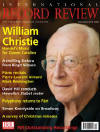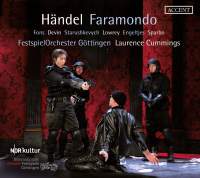Texte paru dans: / Appeared in:
*

International Record Review - (12//2014)
Pour
s'abonner / Subscription information
Accent
ACC26402

Code-barres / Barcode : 4015023264021
Consultez toutes les évaluations recensées pour ce cd
~~~~ Reach all the evaluations located for this CD
Photographs of this recording of Faramondo from Gottingen show a production in which the action has been updated (can directors these days do anything but that?), with men in black leather, wearing helmets and almost obligatorily toting guns (so old‑hat). Laurence Cummings, a very experienced and accomplished exponent of Handel's music, conducts. His cast consists of singers who are not particularly well known. (The only other role in which I have heard the American mezzo Emily Fons is that of Peep‑Bo in The Mikado.) The booklet does include short biographical notes on the singers, as all booklets should.
The plot is complicated even by Handelian standards. Winton Dean described the libretto as 'hopelessly obscure'; Edward J. Dent thought it almost unintelligible, I believe an error in the booklet has been resolved: it printed the English synopsis for Siroe. Going in to every nook and cranny of the story and the interrelationship of characters would occupy more space than is available.
Gustavo, King of the Cimbrians, declares war on Faramondo, King of the Franks, for killing his son Sveno in battle, and offers his daughter Rosimonda to anyone who brings him Faramondo's head. From there it becomes so involved. Faramondo's sister Clotilde is condemned to death for being who she is. She is loved by Gustavo's son Adolfo. Faramondo is attracted by Rosimonda, who is desired by Gernando, King of the Swabians. Gustavo, meanwhile, expresses his love for Clotilde, who asks Adolfo to defend her. He prevents his father from killing Faramondo and is exiled as a result. I do hope readers are following this, for this is still Act 1. The complications continue, so let me close this by saying that the opera ends with the announcement that Teobaldo, Gustavo's captain before turning against him, has confessed that Sveno, believed to have been killed, remember, is still alive as Childerico. Teobaldo had exchanged Sveno for his own son, so Gustavo's hatred for Faramondo was misplaced. Clotilde and Adolfo are together, Rosimonda and Faramondo are united.
This Accent version, with applause, lasts ten minutes longer than the Virgin recording mentioned as a comparison, but the main difference is that Faramondo is sung by a mezzo against Virgin's countertenor (Max Emanuel Cencic). The small role of Childerico (no aria) is also given to a countertenor in that earlier set but here to a soprano. The present cast may seem not to match Virgin’s on paper but in fact a high standard is set. Where have they been hiding Fons? She has a focused, dark‑hued voice with the suppleness to transcend the coloratura of such arias as 'Sebben me lusinga', which closes Act 1. (Cencic offers skilful technique too.) Dean complains that it does not suit Faramondo's sentiments. He is right, but it does test the singer's ability, and Fons comes through with honours, as she does in other such pieces, magnificently in 'Voglio che sia l’indegno' in Act 3, considered by Dean to show Handel at his greatest. She is admirable also in the elegant, slow 'Poi che pria di morire' in Act 2 with its measured tread. That act closes with a captivating duet, 'Vado e vivo', for Faramondo and Rosimonda, in which Fons joins Ukraine's Anna Starushkevych in the infrequent combination of two mezzos, benefiting from their blended tones. On Virgin, however, the duet is delivered much more swiftly by Diego Fasolis (2'15" to Cumming's 3'47") with countertenor Cencic taking the higher line over that of the rich‑voiced mezzo Marina De Liso. Appropriately, it is Faramondo who has the final aria, its melody then taken by the full cast to celebrate virtue.
Fons is not the only soloist worthy of praise. Starushkevych, winner of the Handel Singing Competition in London in 2012, also possesses a voice with the necessary agility, as one can hear in 'Si, l’intendesti, si' in Act 2, in which she provides the strength of tone to rail against Gernando, calling him 'Barbaro traditor' ('Cruel traitor'). As I have hinted, the Virgin recording also casts Rosimonda strongly in selecting De Liso, whom I have praised in these pages before. The Irish soprano Anna Devin is in no way inferior to the two mezzos, her Clotilde overcoming all the rising and falling roulades in a voice that has some body to it: not the lightness of a soubrette. 'Combattuta da due venti', 'a spectacular showpiece' in Dean's words, surely needs a singer with the fullness of tone and the technical ability to negotiate the twists and turns. In Devin, it has one.
Virgin's four countertenors are reduced to two in Gottingen's performance. Maarten Engeltjes has less weight of voice than does Christopher Lowrey, as befits his singing the role of a goody rather than the latter's baddy. Both voices move easily up and down the scales. The Dutch singer is softer in timbre than Lowrey, who has a darker hue and more of a bite to the tone as heard bere.Edward Grint is firm of vocal production. I am less happy with the Norwegian bass-baritone Njål Sparbo, whose voice is rather dry with a surface rather rough, as if it were vocal emery paper. He makes one aware, nevertheless, that Gustavo does not have the sweetest nature.
One must make a personal preference as regards tempos, but Cummings and his orchestra do full justice to the music. Choice between this and the Virgin set is not straightforward. Studio versus live is one consideration, with clumps and bumps in the latter which may deter some collectors. Gottingen's ambience may be a little hollow, which could dissuade others, similarly Virgin's plethora of countertenors. Putting these external issues aside, if we can, which set would I recommend? That's difficult. Which would I buy? Both, if money is no object.
Cliquez l'un ou l'autre
bouton pour découvrir bien d'autres critiques de CD
Click either button for many other reviews


